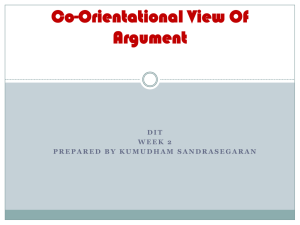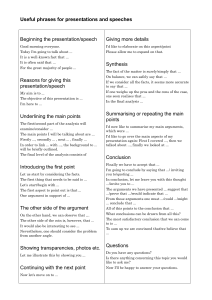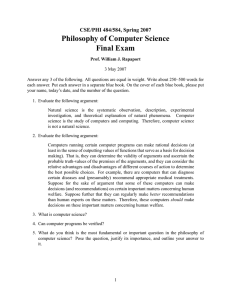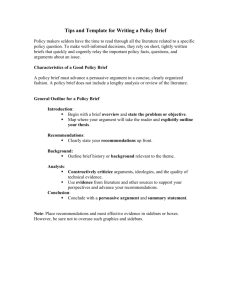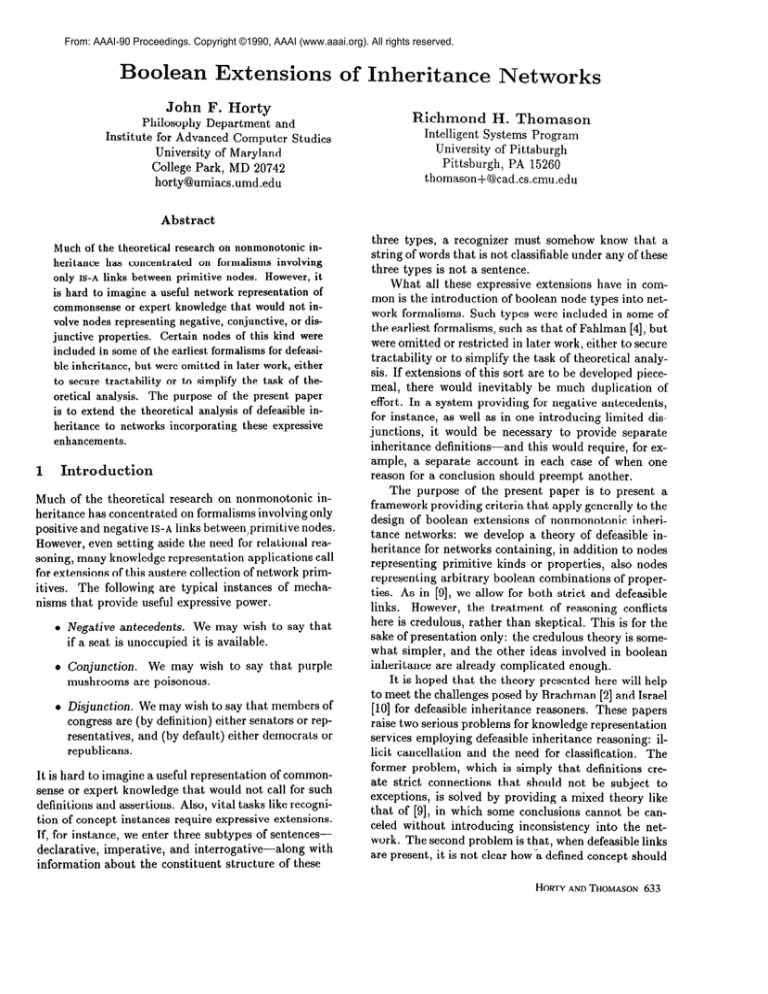
From: AAAI-90 Proceedings. Copyright ©1990, AAAI (www.aaai.org). All rights reserved.
Boolean
Extensions
o
John F. Horty
Philosophy Department and
Institute for Advanced Computer Studies
University of Maryland
College Park, MD 20742
horty@umiacs.umd.edu
Inheritance
Richmond
N&wo&s
H. Thomason
Intelligent Systems Program
University of Pittsburgh
Pittsburgh, PA 15260
thomason+@cad.cs.cmu.edu
Abstract
Much of the theoretical
heritance
has
concentrated
only IS-A links between
is hard
to imagine
commonsense
research
on formalisms
primitive
knowledge
volve nodes representing
in some of the earliest
to secure
tractability
oretical analysis.
is to extend
The
in later
or to simplify
purpose
the theoretical
heritance to networks incorporating
enhancements.
1
or dis-
for defeasiwork, either
the task
of the present
analysis
of
of this kind were
formalisms
but were omitted
it
would not in-
conjunctive,
nodes
included
However,
representation
that
negative,
Certain
properties.
in-
involving
nodes.
a useful network
or expert
junctive
ble inheritance,
on nonmonotonic
of thepaper
of defeasible
in-
these expressive
Introduction
Much of the theoretical research on nonmonotonic
inheritance has concentrated on formalisms involving only
positive and negative IS-A links between,primitive
nodes.
However, even setting aside the need for relational reasoning, many knowledge representation applications call
for extensions of this austere collection of network primitives. The following are typical instances of mechanisms that provide useful expressive power.
e Negative antecedents.
if a seat is unoccupied
We may wish to say that
it is availa,ble.
We may wish to say that purple
0 Conjunction.
mushrooms are poisonous.
e Disjunction.
We may wish to say that members of
congress are (by definition) either senators or representatives, and (by default) either democrats or
republicans.
It is hard to imagine a useful representation of commonsense or expert knowledge that would not call for such
definitions and assertions. Also, vital tasks like recognition of concept instances require expressive extensions.
If, for instance, we enter three subtypes of sentencesdeclarative, imperative, and interrogative-along
with
information about the constituent structure of these
three types, a recognizer must somehow know that a
string of words that is not classifiable under any of these
three types is not a sentence.
What all these expressive extensions have in common is the introduction of boolean node types into network formalisms.
Such types were included in some of
the earliest formalisms, such as that of Fahlman [4], but
were omitted or restricted in later work, either to secure
tractability or to simplify the task of theoretical analysis. If extensions of this sort are to be developed piecemeal, there would inevitably be much duplication
of
effort. In a system providing for negative antecedents,
for instance, as well as in one introducing limited disjunctions,
it would be necessary to provide separate
inheritance definitions-and
this would require, for example, a separate account in each case of when one
reason for a conclusion should preempt another.
The purpose of the present paper is to present a
framework providing criteria that apply generally to the
design of boolean extensions of nonmonotonic
inheritance networks: we develop a theory of defeasible inheritance for networks containing, in addition to nodes
representing primitive kinds or properties, also nodes
representing arbitrary boolean combinations of properties. As in [9], we allow for both strict and defeasible
links.
However, the treatment of reasoning conflicts
here is credulous, rather than skeptical. This is for the
sake of presentation only: the credulous theory is somewhat simpler, and the other ideas involved in boolean
inheritance are already complicated enough.
It is hoped that the theory presented here will help
to meet the challenges posed by Brachman [2] and Israel
[lo] for defeasible inheritance reasoners. These papers
raise two serious problems for knowledge representation
services employing defeasible inheritance reasoning: illicit cancellation
and the need for classification.
The
former problem, which is simply that definitions create strict connections
that should not be subject to
exceptions, is solved by providing a mixed theory like
that of [9], in which some conclusions cannot be canceled without introducing
inconsistency
into the network. The second problem is that, when defeasible links
are present, it is not clear how a defined concept should
HORTY AND THOMASON 633
be placed in an inheritance hierarchy. In view of the
usefulness of the classifier in KL-ONE style systems, this
challenge has to be taken very seriously.
The theory of [9] d oes not deal with this classification issue, because the mixed system of that paper does not provide for complex concepts.
Since the
present work, however, gives an account of the conclusions derivable from a defeasible network containing
boolean-defined
concepts, it provides also a specification for a classification algorithm in this boolean case.
Admittedly, implementing such an algorithm would entangle us in intractability problems; but such entanglements also arise in purely monotonic settings. As far
as we know at present, intractability
problems are not
necessarily worsened by the presence of defeasible links.
2
2.1
Basic concepts
Nodes
and arguments
Nodes representing objects or individuals are depicted,
as usual, by lowercase
letters from the beginning of the
“..
alphabet (a through d). Nodes representing kinds or
properties of individuals,
however, may now be compound.
Simple nodes, representing primitive properties, are depicted by lowercase letters from the middle
of the alphabet (f through t). Compound
property
nodes are then obtained by closing the simple property
nodes under the boolean operations of A, V, and 1; the
nodes belonging to this closure, both simple and compound, will be depicted by uppercase letters from the
middle of the alphabet (F through 7’). Capital letters
from the end of the alphabet (U through 2) range over
nodes in general, both individual nodes and property
nodes.
Although we generally use infix notation in examples, we take the boolean operations of A and V officially to operate on sets of nodes; thus, for instance,
FAGAH
is the result of applying conjunction to the set
{F, G, H}. (It will b e convenient to take the conjunction and disjunction of a unit set to refer to that set’s
only member.)
The compound
property nodes should
be interpreted in the obvious way: if F and G are properties, then the nodes the nodes FAG,
F V G, and TF
represent the property of being both an F and a G, the
property of being either an F or a G, and the property
of not being an F, respectively.
We allow for both strict and defeasible links.
A
strict link has the form X 3 F. If X is itself a property node, such a link is equivalent in meaning to a
universally quantified material conditional;
for example, the link p A 4 + Y might represent the statement
‘All purple mushrooms are poisonous’.
If X is an individual node, a strict link will mean that this individual
possesses the property F; the link a a l(p A q), for
example, might represent the statement ‘Albert is not
634 KNOWLEDGEREPRESENTATION
A defeasible link has the form
a purple mushroom’.
X + F.
If X is a property node, such a link is to
be interpreted as a defeasible generic statement;
the
link p A q + f might represent the statement ‘Purple
mushrooms tend to be poisonous’.
It is harder to find a
natural reading for these defeasible links when X is an
object, but we can assume that they represent defeasible assertions about the properties of individuals; the
link a + l(p A q), then, might represent a statement
like ‘It is most natural to suppose that Albert is not a
purple mushroom’.
In theories of inheritance that allow only primitive
nodes, reasoning processes can be represented by paths,
or linear sequences of links. With the addition of compound nodes, however, inheritance networks are able to
support more complicated
patterns of reasoning.
We
represent these patterns using certain kinds of proof
trees, called arguments;
we refer to them by lowercase
Greek letters (a:, ,f?, y, . . .).
Arguments will be classified as strict or defeasible,
simple or compound; and with each argument cv there is
associated a premise node P(o) and a conclusion node
C(o).
These are analogous to the two nodes, in ordinary inheritance, standing at the beginning and the
end of a reasoning path. An argument supports a conditional statement constructed out of its premise and
conclusion.
If o is a strict argument, it supports the
statement P(o) j C(a); if o! is a defeasible argument,
it supports the statement P(o) + C(o).
The simple arguments are those containing only one
inference. If X1 A - - - A X, is a node, then the tree
is a simple strict argument, with P(a) = X1 A - - - A X,
and C(a) = F. Likewise, for any node X, the tree
CV=
X
F
-
is a simple defeasible argument, with P(o)
= X and
C(a!) = F. Compound
arguments are defined inductively by the following clauses, in which the bracketed
components are optional.
1. Ifal,..
. , on are strict arguments and l\{p(ai),
P(cE,),
[Xl,. . . ,X,1}
is a node, then
“‘,
CYl
*a*
CY=
[Xl
Qn
.a.
xl
F
is a compound
l\(P(m),
F.
strict argument,
. . . , p(w&
[Xl,.
with P(o)
. . ,&J)
=
and C(a)
=
(Y, are arguments at least one of which
2. If&l,...,
is defeasible, and P(cQ) = X for each oi, then
a =
ct!l
an
...
ix1
F
is a compound defeasible
X and C(o) = F.l
3. If 01 is any argument,
P(cQ) = X, then
is a compound defeasible
X and C(o) = F.
argument,
with P(a)
strict or defeasible,
argument,
=
with
with P(o)
=
In addition to specifying the arguments themselves, this
definition allows us also to classify inferences contained
in an argument as strict or defeasible: a double inference bar, analogous to the double-arrow link, indicates
that the inference is strict; a single inference bar, analogous to the single-arrow link, indicates that it is defeasible.
The arguments defined here are intended as a generalization of the standard inheritance paths; a path is
simply an argument that does not branch. To save vertical space, we will use ordinary path notation from [9]
to refer to those arguments that can be identified with
paths. For the same reason, we will occasionally write
those compound arguments defined by the third clause
above horizontally, as (al/F)
.
2.2
Nets,
theories,
and extensions
Capital Greek letters from the beginning of the alphabet (I’, A, 0,. . .) stand for networks, which are finite sets of links; those from the end of the alphabet
(a, E, Q, . . .) stand for sets of arguments.
Intuitively,
the statements belonging to a network are supposed
to represent the information provided as hypotheses to
some reasoning agent. We imagine this agent developing a body of accepted arguments in stages, by a process of argument formation and ratification.
Since arguments are a means of constructing other arguments,
at any stage in this process there will be an argument
set, consisting of patterns of reasoning that have been
explicitly carried out and accepted.
The relation of support already defined between arguments and statements can be extended in the obvious
way to a relation between argument sets and statement
‘The reason why a common premise is required when defeasible arguments are combined is that defeasible arguments can
be compared and combined only with respect to the same total
background evidence. This common evidence is represented here
by the shared premise.
sets: an argument set Q will be said to support a statement set A just in case A is the set of statements supported by the arguments in a.
The primary task for a proof-theoretic
account of
inheritance networks is to specify the theories associated with each network-the
statement sets that an
ideal reasoner could arrive at, given the information in
that network as hypotheses. Following the strategy developed in previous work on inheritance networks, we
approach this task here in a roundabout way. We first
define the relation between a network and certain argument sets known as the extensions of that network; intuitively, these represent alternative argument sets that
an ideal reasoner would be able to accept, based on the
initial information contained in the network. Once this
relation has been defined, it is then a simple matter to
specify the theories associated with a network: A is a
theory of the net I’ just in case there is an extension of
I’ that supports A.
3
Inheritability
If I’ is a network and @ is some set of arguments, we
describe the pair (I’, @) a~ an epistemic context.
Although, formally, any such pairing of a net and an argument set counts as a context, it is part of the intuitive
picture that the argument set should arise out of the
net. In any given context, certain arguments can be
classified as inheritable-forcible
or persuasive. We use
the symbol ‘k ’ to stand for this relation of inheritability, SO that ‘(I, a) k o’ means that the argument Q is
inheritable in the context (I’, Q).
This notion of inheritability
is the central concept
in our proof-theoretic
account of inheritance networks.
In the present section, we set out an appropriate notion of inheritability
for arguments.
This notion will
then be used in the following section to provide a definition of credulous extensions for inheritance networks
containing compound nodes.
3.1
Motivation
By appealing to logic, it is easy to specify the conditions under which strict arguments, at least, should be
classified as inheritable in a context. Suppose we have
chosen some background logic for the boolean connectives; this logic will determine a consequence relation t-.
In fact, the account of inheritance presented in this paper can be cast against a number of background logics,
but for reasons described in Thomason et al. [12], the
most promising candidate seems to be the four-valued
logic of Belnap [ 11. N ow imagine, for a moment, that we
interpret the nodes as propositions rather than properties; and that we supplement our background logic with
the strict statements belonging to some net I’ as addiHORTYANDTHOMASON
635
tional rules of inference. This leads to a new logic, with
a new consequence relation l-r-. We say that a strict argument is F-valid if the conclusion of each inference in
the argument, regarded as a proposition,
follows from
its premises in the logic b ; and we will say that such
an argument is inheritable in the context (I’, @) if it is
P-valid.
The intuitive idea behind this treatment of the strict
arguments can be described as follows.
Initially, we
construe all nodes as properties (this includes individuals, since we can interpret the node a as the property
of being CL). Each strict link in the net then induces
a new logical rule of inference involving a single free
variable, say 2: the link p j q, for instance, leads to
the rule of inference p(z)/q(z);
the link a + p leads
to 2 = a/p(x).
We want to evaluate strict arguments
against this new predicate logic determined by the net.
However, since we are reasoning about statements containing only a single free variable, it suffices to treat
the logic as propositional,
and the nodes as propositions.
Notice that, for the four-valued logic, and for
any other reasonable logic of the boolean connectives,
this treatment already provides, even for entirely strict
arguments, a polynomial reduction of inheritability to
an NP-complete
problem.
We turn now to the matter of inheritability for defeasible arguments; and here, we focus on the special
case of compound defeasible arguments ending in a defeasible inference.
This is really the most interesting
case, since it forces us to isolate the conditions under
which an inference can be drawn using defeasible information.
Once the case is understood,
it is then a
simple matter to embed it in a general definition of inheritability.
For arguments of this kind, the account
we provide is modeled on that of Touretzky [13] : such
an argument will be classified as inheritable in a context if it is constructible, but neither conflicted nor preempted. These key concepts-constructibility,
conflict,
and preemption-are
defined by Touretzky for paths.
Our task here is to generalize them in such a way that
they will apply to arguments as well.
The generalization
is unproblematic
in the case of
constructibility.
We adopt the following definition, which
captures the idea that the arguments constructible
in
a context are those that can be assembled by chaining together, in a certain way, the arguments and links
already present in that context.
Definition
1 (Constructibility)
Let a, be an argument of the form (c~l/Y),
with C(cxl) = U. Then cy
is constructible
in the contezt (I’, @) ifl cy1 E @ and
u-49x
It is helpful to think of the final inference, or link,
in a constructible
argument as a reason for accepting
that argument.
Suppose, for example, that the agent
636 KNOWLEDGEREPRESENTATION
Figure 2: I’2
Figure 1: I’1
isgiventhenetI’r={a+p,a+q,pAq+r}ashis
initial information, where p = purple things, q = mushrooms, and r = poisonous things. This net is shown in
Figure 1, in which the compound conjunctive node p Aq
is depicted as a conjunction
sign with double-barbed
arrows pointing at its conjuncts (disjunctive and negative nodes will be depicted in a similar fashion).
Now
let
a
a
=
=
=
a!
V
Q
PM
and /3 = (a/r);
and supp ose that the reasoning agent
has already accepted the argument cr, so that he is in
the epistemic context (I’, @) with Q = I’ U {oy). In this
new context, the argument /3 is constructible.
Since
the agent has already accepted the argument that a is
a purple mushroom, the link pA q + r, telling him that
purple mushrooms are poisonous, gives him a reason to
accept the argument that a is poisonous.
Constructibility
is a necessary condition that an argument of this kind must satisfy in order to be classified as inheritable, but it is not sufficient. Even if an
argument is constructible
in some context, it will not
be classified as inheritable if it is either conflicted or
preempted.
The intuitive force of the requirement that a conflicted argument should not be inheritable is that the
agent must check for consistency before accepting arguments. An argument cannot be classified as persuasiveeven if there is some reason for accepting it-whenever
the adoption of that argument would introduce a conflict into an epistemic context.
The need for this requirement is usually illustrated by the familiar Nixon
Diamond. Once an agent has embraced, say, the argument that Nixon is a pacifist, he can no longer accept
the conflicting argument that Nixon is not a pacifist.
The generalization of the notion of conflictedness to
nets with compound
nodes is nontrivial, because the
more powerful strict consequence relation provided by
boolean nodes can make conflicts indirect.
To illustrate this possibility, suppose that the reasoner is given
as his initial information
the net I?2 = (a 3 p,p ---)
s,a 3 q,q + t,a * ~(s A t)}, depicted in Figure 2;
and suppose also that he has already accepted the argument a =) q ---) t, so that his epistemic context is
(I’z,@) with @ = l?2 U {a + q + t}. Here, the argument a + p * s would introduce a conflict into the
context, even though the context does not contain an
explicit argument to the contrary.
In order to generalize the notion of conflict to handle
cases like this, we need to introduce a few preliminary
ideas. First, where @ is an argument set and X is a
node, we let @(X) = (C(o) : (Y E Q and P(Q) = X).
This set can be thought of as the projection of Q onto
X; it tells us what an agent who has accepted all the
arguments in ip has concluded in particular about X.
Next, we say in the obvious way that a set of nodes F
is a conjlict set in l? iff F b 2 and F b 12, for some
node 2; and that F is a minimal conflict set in I’ (a
I’-mcs) iff F but none of its proper subsets is a conflict
set in I’. Using these ideas, the notion of a conflicted
argument can be defined as follows.
Definition 2 (Conflict)
Let a be an argument of the
form (al/Y),
with P(cq)
= X.
Then (Y is conflicted
in the context (I’, a) i$ there is a r-mcs 3 such that
YE3and3-(Y)C:@(X).
In the example above, it can now be seen that the argument a * p ---) s is conflicted in the context (I’2, a),
since F = (s, t, l(sAt))
is a Pa-mcs and F-(s)
C @(a).
The appeal to minimal conflict sets in the definition above is one way of capturing the idea that a
path is conflicted only if it is somehow responsible for
a conflict2
Why not simply say in the definition above
that (or/Y)
is conflicted in (I’, @) if Q(X) U {Y} is a
conflict set in I’? The problem with this simpler formulation is that it does not properly capture the idea
that a path is conflicted only if it introduces a conflict into a context;
and as a result, it classifies too
many paths as conflicted.
Consider, for example, the
net
(a + p, a + -p, a a q, q + r), depicted in
Figure 3. Suppose the agent has drawn no inferences,
so that he is in the context (I’, @a>,with @ = l?. According to the simpler analysis, the argument a + q + r
would have to count as conflicted, since (a(u) U (r) is a
conflict set. But according to the official analysis contained in our definition, a 3 q -+ T does not count as
conflicted, since it does not introduce a conflict into the
context. It seems that this official analysis of conflictedness is preferable: rs contains a little bit of inconsistency elsewhere, but it gives us no real reason not to
conclude that a is a r.
r3 =
2There may be other, more natural mechanisms
this notion of blame for a conflict.
for capturing
Jl
.
4
T. p3-0
\I/
.
4
Figure 3: l?s
9e
Figure 4: I’4
Like a conflicted argument, an argument that is preempted cannot be classified as inheritable.
An ideal
reasoner should not view an argument as persuasive
whenever his context provides him with a more specific reason for accepting a conflicting argument. The
notion of specificity appealed to here is carried over directly from simple inheritance:
we say that V <a U
iff U E a(V);
and that V <G U, meaning that V is a
specific kind of U, iff V sa U but it is not the case
that U <,a V. Using this idea of specificity, the notion
of preemption can be defined as follows.
Definition
3 (Preemption)
Let a be an argument of
the form (al/Y),
with P(cy1) = X and C(al)
= U.
Then o is preempted in the context (I’, @) ifl there are
nodes V and W such that
1. X s*
V and V <.g U,
2. V + W E I? and there is a I?-mcs 3
W,Y~3and3-{W,Y)54P(X).
such that
The first clause of this definition tells us that V represents a better reason than U for drawing conclusions
about X; the second clause tells us that V suggests a
conclusion about X that conflicts in the context with
the conclusion suggested by U. Again, it would be simpler to replace the second clause with a stipulation to
is a
the effect that V -+ W E l? and a(X) U {W,Y}
conflict set; but this would often lead to the wrong results. For example, with the simpler stipulation,
the
path x 3 u -+ y would b e improperly preempted in
the context (r,l?),
where r = {X + U,U ---) y, x Gv,vuu,v--+w,x~~w).
To illustrate the notion of preemption, let us suppose that the reasoner is given as his initial information the net l?h = (a 3 m,m * n,a * 0,n --) p,o -+
!l,(Pkl)
* r,m --) lr}, illustrated in Figure 4. Just to
give the net some concreteness, we adopt the following
q = peointerpretation:
p = people with Disease-l,
ple with Disease-2, r = people exhibiting Symptom-3,
HORTYANDTHOMASON
637
n = people who have spent time on Island-l, o = people who have spent time on Island-2, m = people who
have spent time in some particular swamp on Island1. Under this interpretation,
what I4 tells us is that
the Island-l people tend to acquire Disease-l, that the
Island-2 people tend to acquire Disease-2, that anyone
with both of these diseases must exhibit Symptom-3,
that the swamp people tend not to exhibit this symptom, and that the individual a has spent time both on
Island-2 and in the Island-l swamp. Now suppose that
the agent has reasoned his way to the epistemic context
(r4, Q), where @ =
u {a 3 m * n,a * 0 + q);
that is, he has already decided that a has Disease2. In this context, he will find that the argument
a 3 m + n + p is preempted by the more specific
argument a * m + ir.
Definition
Case A: a(o) # a and S(a) # {cu}.
iflu(cu) E @ and S(a) C Qp.
Case B: a(a)
Case
Case
r4
3.2
The
definition
At this point, we can embed the special cases of inheritability that we have considered into a general definition. It is convenient to begin by introducing some
notation,
analogous to that of [9], for analyzing the
structure of arguments. Where (Y is an argument tree,
we let a(a) be the maximal strict subtree of cx beginning with its root inference; and we let S(o) be the
set of argument trees that remains when a(a) is truncated from o. These concepts are easier to illustrate
than to define precisely; so suppose that o is the argument
Y
In that case, we would have
4 (Inheritability)
C-I:
= CY. Then
S(a)
= {a}
Then
(I’, a) k Q i$cr
(I’,@)
k a!
isJ’-valid.
and cv is a direct link.
Then
and Q is a compound
path.
(r, a) )- LYifla E r.
C-II: S(Q) = {o}
Then (I’,(a) k cx i$
1. o is constructible
2. Q is not conflicted
3. a~ is not preempted
in (I’,@),
in (I’, a),
in (I’, @).
Here, Case A reduces the question of inheritability for
a defeasible argument ending in a strict inference to
two questions: inheritability for a strict argument and
inheritability
for arguments ending in a defeasible inference. These are treated in Cases B and C.
4
Credulous
extensions
With the relation of defeasible inheritability secured, it
is straightforward
to define the credulous extensions of
the inheritance networks containing compound
nodes.
Intuitively, an extension is supposed to represent some
total set of arguments that an ideal reasoner would be
able to accept, based on the initial information in some
network. Therefore, we need only ask: what could prevent a path set <p from representing such an ideal set
of arguments determined by the net I’? There are two
possibilities.
First, @ might contain too few arguments;
there might be some argument inheritable in the context (l?, @) that does not actually belong to a.
Or
second, Qi might contain too many arguments; some argument actually belonging to @ might turn out not to
be inheritable in the context. The credulous extensions
of a net I’ can be defined as those path sets exhibiting
neither of these defects.
Definition 5 The argument set @ is a credulous
tension of the theory I’ ifl@ = {(w : (I’, @) )- cu}.
and
Q
=
!l
a
S(a)
=
P
{
r
7
a
-
S
.
I
Using this notation, we can classify the arguments
according to their structure as follows. An argument Q
might end in a strict inference without without being
entirely strict, in which case we would have a(a) # o
and S(o) # {a}. Alt ernatively, the argument might be
entirely strict, in which case we would have a(o) = Q,
or it might end with a defeasible inference, in which case
we would have 6(a) = {a}. We use this classification of
arguments to define inheritability for argument trees.
638
KNOWLEDGEREPRESENTATION
ex-
One requirement of the theory of skeptical mixed inheritance from [9] was that it should specialize to previously formulated skeptical theories of strict and defeasible inheritance. In the same way, it can be shown that
the theory of boolean inheritance presented here specializes to the mixed theory of [7], a forward-chaining
variant of the original credulous theory of inheritance
from Touretzky
[13]. Criteria guaranteeing the existence of extensions for boolean nets, and also the properties of soundness and stability, are established in [S],
which describes a defeasible logic from which the present
treatment of inheritance is descended.
5
Conclusion
The main result of the paper is a generalization Touretzky’s familiar inheritance definition to networks containing boolean-defined
nodes. We have concentrated
on motivating this definition, and have not discussed
the independent
problem of providing a model theoretic semantics for the theory; this problem is complex
and somewhat problematic
even in the case of simple
inheritance. It seems however, that certain model theoretic studies of simple inheritance networks, such as
those of Gelfond and Przymusinska [5] or Ginsberg [6],
could be extended to the boolean system of this paper.
In obtaining generality, our inheritance formalism
also becomes intractable; as we have pointed out, there
is a polynomial reduction of inheritance in our system
to the problem of boolean satisfiability.
We have tried
to keep an open mind on whether it is best to secure
a polynomial
inheritance algorithm at all costs, or to
provide expressive adequacy even if this requires intractable algorithms.
It remains to be established that
special-purpose
representation
problems can be fully
supported by tractable algorithms, so that the representation tasks can be served without user-defined calls
to the programming
language that underlies the representation system. In the case of medical applications,
for example, Doyle and Patil [3] argue forcefully that
expressive extensions are needed for KL-ONE
style systems. The special-purpose
problem of representing syntactic structures in natural languages provides another
case in point. So far, the formalisms that have been developed for this purpose have been highly intractable,
though in this application one would hope for tractability (see Shieber [ll] for background).
Whether we seek tractable fragments of the full theory or begin with a powerful theorem-proving
implementation of the full system, it seems impossible
to
avoid the need for careful testing of the system under
field conditions.
Both sorts of systems need to be tested
for expressive adequacy and for practical efficiency, but
with different emphases in the testing. The theory of
this paper serves as a first step in designing implementations of both sorts.
Acknowledgments
This material is based on work supported by the National Science Foundation under Grant No. IRI-8700705,
and by the Army Research Office under Grant No. DAAL03-8%K0087.
References
[l] N. Belnap.
A useful four-valued
logic. In Modern
Uses of Multiple-valued
Logic, J. Dunn and G. Epstein (eds.), D. Reidel (1977), pp. 8-37.
[2] R. Brachman. “I lied about the trees” or, defaults
and definitions in knowledge representation.
The
AI Magazine, vol. 6 (Fall, 1985), pp. 80-93.
[3] J. Doyle and R. Patil. Two dogmas of knowledge
language restrictions,
taxonomic
representation:
classification, and the utility of representation services. MIT/LCS
Technical Report 387.b (1989).
[4] S. Fahlman.
NETL:
and Using Real-world
(1979).
a System for Representing
Knowledge. The MIT Press
[5] M. Gelfond and H. Przymusinska. Formalization of
inheritance reasoning in autoepistemic
logic. Unpublished manuscript,
University of Texas at El
Paso (1990).
[6] M. Ginsberg. A 1ocal formalization of inheritance:
preliminary
report.
Unpublished
manuscript,
Stanford University (1990).
[7] J. Horty. A credulous theory of mixed inheritance.
Hierarchies in Knowb
Forthcoming in Inheritance
edge Representation,
M. Lenzerini, D. Nardi, and
M. Simi (eds.), John Wiley and Sons (1990).
[8] J. Horty. Defeasible arguments:
an extension of
path-based reasoning. Technical Report, Institute
for Advanced
Computer
Studies, University of
Maryland (1990).
[9] J. Horty and R. Thomason.
Mixing strict and defeasible inheritance. Proceedings of AAAI-88, Morgan Kaufmann (1988), pp. 427-432.
[lo]
D. Israel and R. Brachman.
Some remarks on
the semantics of representation
languages. In On
Conceptual Modeling:
Perspectives from Artificial
Intelligence,
Databases,
and Programming
Languages, M. Brodie, J. Mylopoulos,
and J. Schmidt
(eds.), Springer-Verlag
(1984).
[ll]
S. Shieber. An Introduction
to Unification-based
Approached
to Grammar. Center for the Study of
Language and Information,
Stanford, CA, (1986).
[12] R. Thomason,
J. Horty, and D. Touretzky. A calculus for inheritance in monotonic semantic nets.
In Methodologies
for intelligent Systems, Z. Ras
and M. Zemankova (eds.), North-Holland
(1987),
pp. 280-287.
[13] D. Touretzky.
The Mathematics
of Inheritance
Systems. Morgan Kaufmann (1986), 220 pp.
HORTYANDTHOMASON
639


